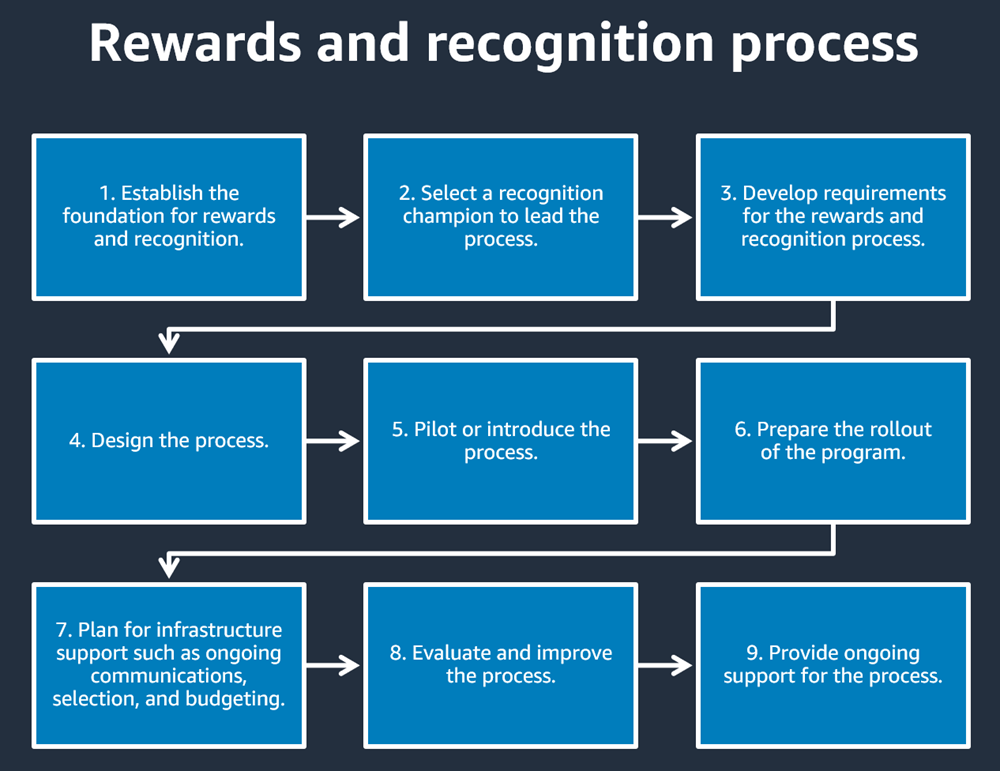5.1 Rewards and recognition
Overview
Rewards and recognition provide a mechanism for highlighting key behaviors and reinforcing them in support of the cloud transformation. Over time, the new behaviors will drive a new culture throughout the organization. A reward is something that is given in return for good behavior or for some service or achievement. A reward can also be a stimulus that follows a correct or desired response and encourages the reoccurrence of the response. Recognition is an acknowledgment, special notice, or attention that highlights an achievement.
A good rewards and recognition system pulls people in because they see what is being rewarded and recognized, they feel good about receiving (and maybe giving) rewards and recognition, and they want to be part of it. However, research indicates that it takes about 20 tries for behaviors to be assimilated into a person's standard patterns. For this reason, organizations require both patience and consistency to fully integrate people into a rewards and recognition culture.
Rewards and recognition provide an appreciation of good work and new behaviors. Employees in a traditional organization might oppose certain behaviors that are necessary for a cloud transformation. In the context of a cloud transformation, leaders should reward and recognize behaviors that might differ from traditional ways of working. For example, experimentation, failing fast, working back from the customer, decentralized decision-making, and cross-functional collaboration might be new behaviors for an organization.
Rewards and recognition should be given to participants in a variety of roles and levels, through a mixture of informal and formal channels, with abundance, and in a timely manner. Timeliness is key to ensuring that the reward or recognition recipients and other observers make the connection between the behavior and its positive consequences. For formal rewards and recognition, follow an established cadence that people can anticipate. Informal rewards and recognition should be ad hoc and involve an element of surprise.
Best practices
Integrate rewards and recognition with a positive, feedback-rich culture. Research shows that higher feedback rates correlate with improved cloud transformation adoption and enablement. High-performing teams typically provide positive feedback five times more frequently than negative or constructive feedback.
Organizations must get a return on reward (ROR) to sustain initiatives. Employees should always know how they are performing against standards through regular feedback.
The objective of rewards and recognition is to identify and consistently reinforce key behaviors that drive business outcomes, and to encourage the widespread adoption of those behaviors. This process helps shape the organization's new culture. An effective reward and recognition system should:
-
Have broad reach across the organization.
-
Measurably affect behavior.
-
Improve results.
-
Offer both tangible and intangible awards that are accessible to all employees.
To foster new behaviors, management systems must measure and reward performance indicators that are aligned with desired results. The workforce needs competencies to navigate the new environment, and accountabilities must be aligned to cloud migration objectives. The ideal outcome is an organization where the new behaviors become the norm.
Initiate the design of the rewards and recognition program in the Envision the Future and Align Leaders stages of the cloud transformation lifecycle, pilot it when you launch the cloud transformation initiative, and then scale the program.
Use culture assessments to understand the desired state and develop key behaviors that reflect the new culture. When you implement such a program, consistent follow-through is crucial to maintain credibility. Maintaining a regular cadence will enhance the impact of the program within the organization.
Additional steps
The following diagram summarizes the steps in the rewards and recognition process.

The diagram illustrates nine high-level steps for developing a rewards and recognition program:
-
Establish the foundation for rewards and recognition.
-
Select a recognition champion to lead the process.
-
Develop requirements for the process.
-
Design the process.
-
Pilot or introduce the process.
-
Prepare the rollout of the rewards and recognition program.
-
Plan for infrastructure support for activities such as ongoing communications, selection, and budgeting.
-
Evaluate and improve the process.
-
Provide ongoing support for rewards and recognition.
The rewards and recognition process includes these details:
-
Follow a process to develop the rewards and recognition program: assess, conduct a workshop, plan, pilot, and incorporate feedback.
-
Understand the desired target culture through culture assessment.
-
Hold a leadership workshop to review assessment results, discuss the desired culture, and determine key behaviors and actions to determine how employees will respond to the rewards and recognition program.
-
Hold a workshop with HR to develop the rewards and recognition program, define any rules, budgetary requirements, or other factors within HR's purview that might be important (for example, employee bonuses or compensation adjustments).
-
Create a rewards and recognition plan based on the outcomes of the workshop.
-
Integrate the rewards and recognition plan with the overall performance management process.
-
Obtain leadership feedback and commitment.
-
Communicate the plan to managers and staff.
-
Incorporate culture training into other training initiatives.
-
Implement the program.
-
Encourage and motivate employees to participate in the program.
-
Assign rewards on a consistent basis.
-
Communicate program updates and rewards publicly.
-
Allocate a budget for rewards and recognition.
A well-designed rewards and recognition program drives cultural change by highlighting key behaviors and reinforcing them consistently. This approach helps create organizational pull for cloud transformation and supports long-term adoption of new ways of working. By following these best practices and steps, organizations can effectively implement a program that measurably affects behavior and improves performance results in support of their cloud transformation initiative.